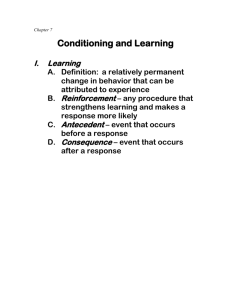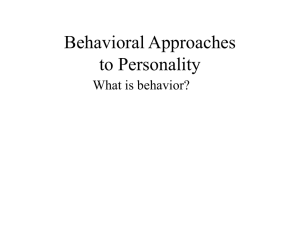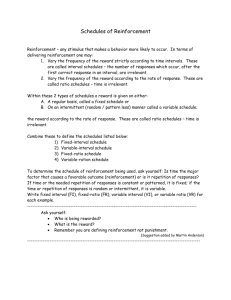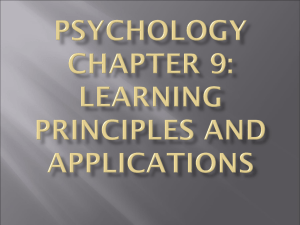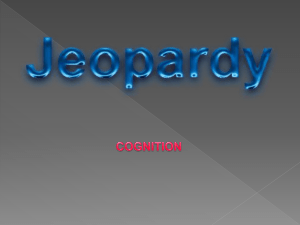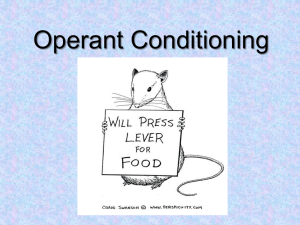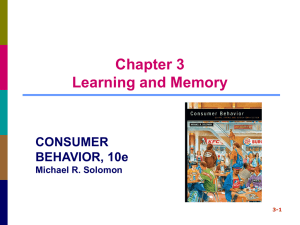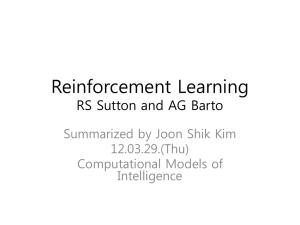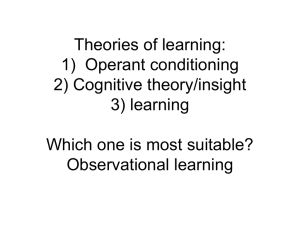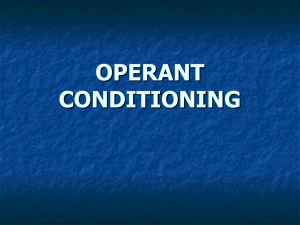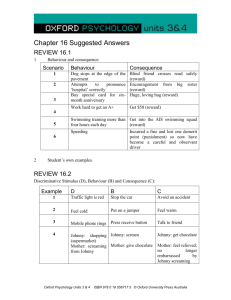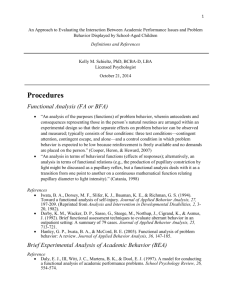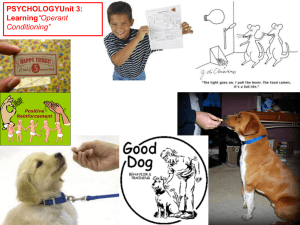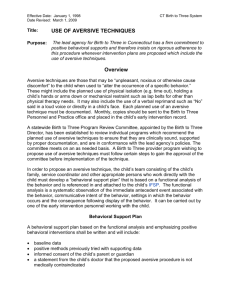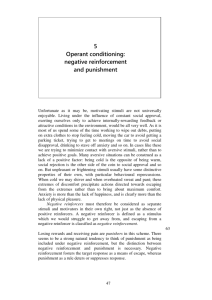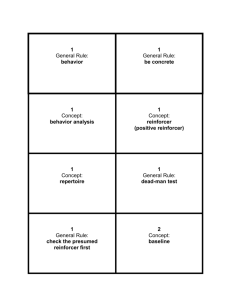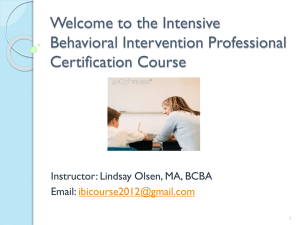Instrumental & Operant Conditioning
advertisement
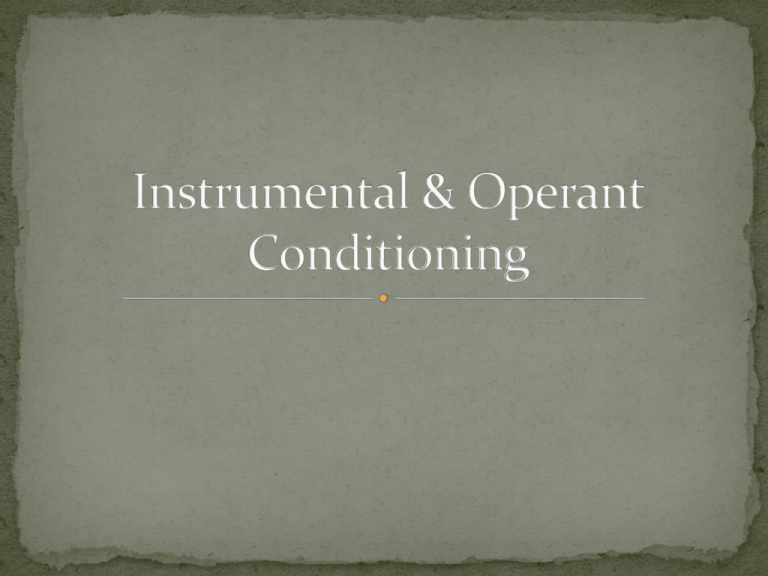
1. 2. What is extinction? Associations are made between a neutral stimulus and an unconditioned stimulus a. b. c. d. 3. Operant conditioning can be described as learning from the consequences of behavior. a. b. 4. Generalization Extinction Classical conditioning Conditioned response True False Which psychiatrist is associated with Operant Conditioning? a. b. c. d. Skinner Freud Watson Pavlov An organisms behavior is instrumental in producing environmental change that in turn affects the organisms behavior Fundamental principle is Thorndike’s Law of Effect Behaviors are encouraged when they are followed by rewarding consequences and discouraged when they are followed by punishing consequences • Can be used to influence the likelihood of an organisms response by controlling the consequences of the response • Developed by B.F. Skinner Practical Uses Educational Strategies Animal Training Behavior Modification Techniques Token Economies Behavior Therapy for Psychological Disorders Shaping Successive approximations of a behavior are reinforced Behaviors that come closer and closer to the final target behavior are reinforced by the training This technique makes it possible to operantly condition behaviors that are not likely to happen otherwise Discriminative Stimulus A stimulus that signals or informs an organism of the availability of reward or consequence Ex the ringing of a phone informs a person that the behavior of answering is likely to be met with the reward of a conversation Ex the presence of a scowl on a parents face signals a teen that the behavior of asking a favor of the parent is likely to be met with rejection These stimuli are valuable when determining when a particular behavior will occur Positive Reinforcement When an appetitive (desired) stimulus follows a behavior. This makes the behavior more likely to recur Negative Reinforcement When a aversive (not desired) stimulus is prevented or eliminated following a behavior This makes the behavior more likely to recur Punishment When an aversive stimulus follows a behavior Results can be varied or controversial Theoretically, it makes the behavior less likely to recur Omission Training When an appetitive stimulus is prevented or eliminated following a behavior This makes the behavior less likely to occur Training Procedures A child has his hand slapped for pulling a dogs tail Punishment, he will be less likely to repeat the behavior A child is given praise for picking up a toy Positive reinforcement, the behavior is more likely to recur A child grabs a toy from her sibling, her mother denies her access to the TV for a period of time. Omission training, the behavior is less likely to recur A child takes out the garbage and her mother stops nagging Negative reinforcement, the behavior is more likely to recur Think about punishment as a parenting technique. What are its advantages? Its disadvantages? Under what circumstances is it appropriate? Inappropriate? Are there effective alternative? What general principles can be developed to govern the use of punishment? Primary Biologically relevant natural events that are capable of increasing the probability of behaviors that produce them Satisfies a biological need Ex water would be a primary reinforcer for a thirsty person Secondary/ Conditioned Neutral event that has taken on reinforcing properties of a primary reinforcer by being associated with it Money is a secondary reinforcer because people have learned it can be used to purchase a variety of primary reinforcers Chaining Extinction The organism is required When a behavior no to perform several different behaviors, in sequence, before the reward is administered longer produces a reinforcer. Under these conditions a behavior eventually ceases Continuous Reinforcement • Every target response is rewarded • Produces behavior that extinguishes easily Fixed Ratio (FR) A fixed number of target repsonse must be made before reward is given Produces a “pause & run” response pattern Variable Ratio (VR) Number of target responses required for reward changes, and the organism never knows how many responses are required for the next reward Produces a consistent, high rate of responding that is very resistant to extinction Partial Reinforcement : Only some correct responses are rewarded Fixed Interval (FI) Variable Interval (VI) The first response after a Similar to the FI schedule, fixed interval of time has passed is rewarded Most of the responses on a FI schedule occur at the end of the interval This pattern is called “scalloping” except that the length of the interval of time changes after each trial, and the organism (you) have no way of knowing how long the next interval will be Response tends to be steady and at a moderate rate A student who studies every Thursday eventing for the regularly scheduled Friday quiz will be rewarded with a good grade. The interval is one week. Fixed Interval A gamblers schedule. No one knows how many lottery tickets must be bought before winning. Variable Ratio A student in class where surprise quizzes are given on random days is rewarded for studying Variable Interval “Buy 10, Get 1 Free!” Fixed Ratio Do you think that students would do school work if there were no grading system? What reinforcements would operate if grades were abolished Procedure Identify the types of reinforcers that operate in your classroom Make a chart that lists the type of reinforcer (primary, secondary, positive, negative) and the classroom behavior it usually elicits Devise a system for your classroom that could replace the existing reinforcers with new ones (and achieve the same results) Analysis Describe how the new reinforcers operate Indicate what responses the new reinforcers are supposed to elicit Punishment Use of punishment is controversial and it effects vary widely When is works, punishment is often intense & immediate Punishment many produce only temporary suppression of the undesired behavior or lead to aggressive behavior, among other things Aversive Conditioning Training with stimuli not desired by the organism Escape Aviodance Occurs when a behavior Occurs when a behavior terminates an aversive events A person can escape a headache (aversive headache) by taking an aspirin(behavior) Both make the behavior more likely in the future happens in the presence of a signal that informs the organism that an aversive event is more likely A person can avoid indigestion(aversive behavior) by taking an antacid(behavior) before eating a spicy dinner(signal that indigestion is likely) A decrease in the responding that occurs after exposure to uncontrollable aversive events A dog exposed to uncontrollable electric shocks are later unable to learn a routine task Learned helplessness helps explain things such as depression and varying levels of job performance Answer the following questions: How can an individual’s use of alcohol and other drugs be explained as positive reinforcement? How can it be explained as negative reinforcement? How could a high school student use principles of operant conditioning to train his or her parents to set a later curfew? Consider the effectiveness of pos On your own… come up with your own examples of schedules of reinforcement Fixed interval Variable interval Fixed ratio Variable ratio Then share with a neighbor! When everyone has shared with their neighbor you will have the choice to share out with the class Insight Learning The sudden awareness of the solution to a problem Wolfgang Kohler, The Mentality of Apes Latent Learning Learning in the absence of apparent reward Edward Tolman Ex rats given an opportunity to explore a maze will develop a cognitive map even when there is no motivation for learning When a reward is avaialbe later, rats that have done this without reward already perform better Observational learning Albert Bandura Learning takes place by watch another individual model the task What negative effects could this have with young children? Biological constraints on learning including innate predispositions influence the likelihood that conditioning occur Rats are predisposed to learn waste aversions Its difficult to train a pig (butnot a raccoon) to put a wooden disk in a piggy bank Instinctive driftwhen an organisms instintive behavior makes it easier or harder to establish a learned response than it would be if the instinctive behavior were not present Biology in Learning Learning is adaptive in that enhances an indivuals ability to survive Culture also influences the kind of learning that can occur, and the environment may limit learning opportunities “Children learn to be more violent from watching television violence.” Take a side. Complete think about it assignment You must include one source and cite it! Responses must be at least 3 paragraphs Quiz over learning on Thursday
